Amazon just announced the upcoming fee changes for UK and EU sellers. In many places, the announcement cited increased cost of improved, faster shipping service to customers as the reason for the fee increases. It was also stated that...
Amazon just announced the upcoming fee changes for UK and EU sellers. In many places, the announcement cited increased cost of improved, faster shipping service to customers as the reason for the fee increases. It was also stated that these 2024 fee changes were designed to reduce “our collective costs.”
While there are some fee reductions in fulfillment, there are others that, in many places for many sellers, will more than offset any savings provided.
Sellers in the comments section of the announcement post expressed frustration and concern about Amazon’s latest round of price hikes. Many mention the impact on their businesses, including the previous loss of Small & Light, being forced use of Amazon Buy Shipping, and increased Royal Mail prices, leading to decreased profitability.
Some sellers are considering diversifying their sales channels due to these challenges, while others criticize Amazon’s customer expectations and support quality despite implementing a yearly increase in fees. Overall, sentiments reflect dissatisfaction and a sense of financial strain caused by the fee changes and evolving policies.
2024 EU FBA Fee Changes at a Glance
While many FBA fulfillment fees are increasing in many countries and across the European Fulfillment Network, domestic fulfillment fees in Germany, France, Italy and Spain will not change. Seller return, disposal and liquidation fees to undergo a major changes beginning February 5, 2024. Local return-to-seller fees will increase and most cross-border returns will do the same with the exception of a couple of lower tiers. Amazon introduces a new returns processing fees for high-return-rate products without addressing within the policy any accountability for fraudulent customer returns or Amazon-at-fault returns. Effective October 1, 2024. The monthly storage fees for peak and non-peak periods will increase on average by 10% starting March 1, 2024. On February 15th, the aged inventory surcharge to increase by over 100% for most tiers. On June 1, 2024, Amazon will implement new fee tiers for the storage utilization surcharge, extending its application to Professional sellers exceeding a storage utilization ratio of 22 weeks. There is no “inbound placement fee” similar to what US sellers have experienced. It appears that the low-level inventory fee is only relevant to pan-EU inventory.FBA Fee Changes: The Yearly Seller Squeeze
The FBA fees remain steady in Germany, France, Italy, and Spain. Yet, in the UK, the Netherlands, Sweden, Poland, and Belgium, the domestic fees will experience a per unit shipped increase, ranging from:
£0.08 to £0.09 for Standard Envelope £0.2 to £0.23 for Small Parcel £0.19 to £0.35 for Standard Parcel £0.26 to £0.48 (+ £0.01 per increase kg) for Standard Oversize £0.54 to £0.72 (+ £0.01 per increase kg) for Large OversizeMeanwhile, rates remain unchanged for Small Envelope and Special Oversize. Moreover,
the Remote Fulfillment fee for shipments from France, Germany, Italy, and Spain to the UK will be lowered, whereas the fees for the EU Fulfillment Network and Remote Fulfillment from the UK to the EU will remain the same.
However, all of the EU fulfillment fees, come with caveats that you will want to be aware of in the footnotes of each rate table, including Amazon reserving the right to make fee adjustments within the EU network when foreign exchange rates change.
Refer to the rate table for details on these adjustments.
Pan-EU Low-Level Inventory Fee
Commencing April 1, 2024, a low-inventory cost coverage fee will be imposed on standard-size products fulfilled through the Pan-European FBA (Pan-EU) program when inventory units fall below 28 days relative to shipped units in Germany, France, Italy, and Spain.
As explained in our 2024 US FBA Fee Changes blog post, the low-level inventory fee is a fulfillment charge tied to the total days of supply at FBA, distinct from a storage fee. It is incurred only upon selling your inventory, triggered upon the fulfillment of the penalized units. The fee ranges from €0.06 to €0.54 per unit.
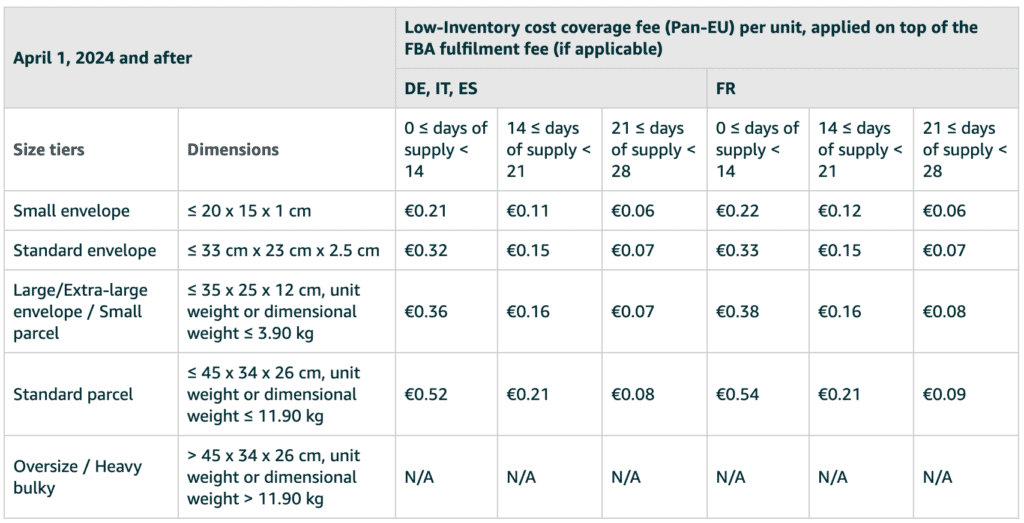
According to Amazon, the low level inventory fee is charged only when both the long-term (last 90 days) and short-term (last 30 days) historical days of supply are less than 28 days; otherwise, sellers won’t face this fee. For instance, if your product’s short-term historical days of supply surpass 28 days while the long-term historical days of supply is below 28 days, the low-inventory fee will not be applicable.
The following sellers are also exempted from this fee:
Professional sellers who are new to Pan-EU (for the first 365 days after the first Pan-EU active date). Seller-FNSKUs that are new to Pan-EU (for the first 180 days after the first Pan-EU active date). Pan-EU seller-FNSKUs with less than five weekly units sold across Pan-EU stores in Germany, France, Italy and Spain.To avoid or minimize the impact of this fee, enhancing the accuracy of your demand forecasts to prevent low inventory levels will be crucial. You may also want to consider adjusting advertising or pricing temporarily to navigate potential surges that can lead to stockouts or low-inventory fees.
Go to FBA Inventory to keep an eye on your historical days of supply.
Monthly Storage Fee Changes
Effective March 1, 2024, there will be an increase in monthly storage fees for oversize products and clothing, shoes, and bags from January to September. Additionally, monthly storage fees for all products, except dangerous goods, will increase from October to December.
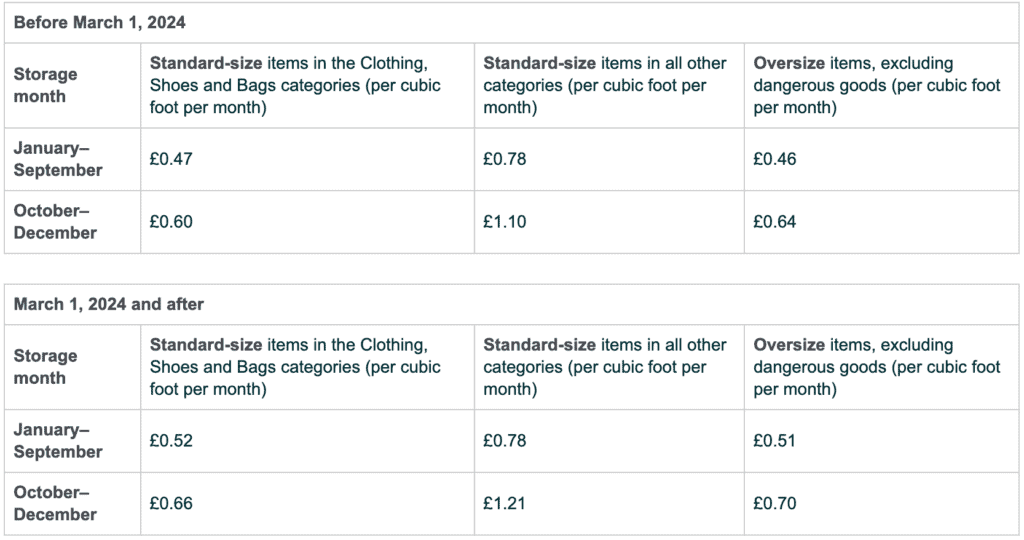
Amazon will also introduce new fee tiers to storage utlization surcharge on June 1, 2024. From having 3 fee tiers (below 26 weeks, 26-39 weeks, and 39 weeks), professional sellers may now be charged a fee if their utilization ratio falls between 22-52+ weeks of total catalog-wide volume.
Meeting the criteria for the surcharge means it will be added to your base monthly storage fee, leading to an increase in total storage costs.
This surcharge is based on the daily average volume, meaning the total amount of storage space that your FBA inventory occupies in FBA. As this is not on a per SKU basis, only sellers with very low volume or very high stagnant inventory will likely face this fee.
January-September Storage Utilization Surcharge
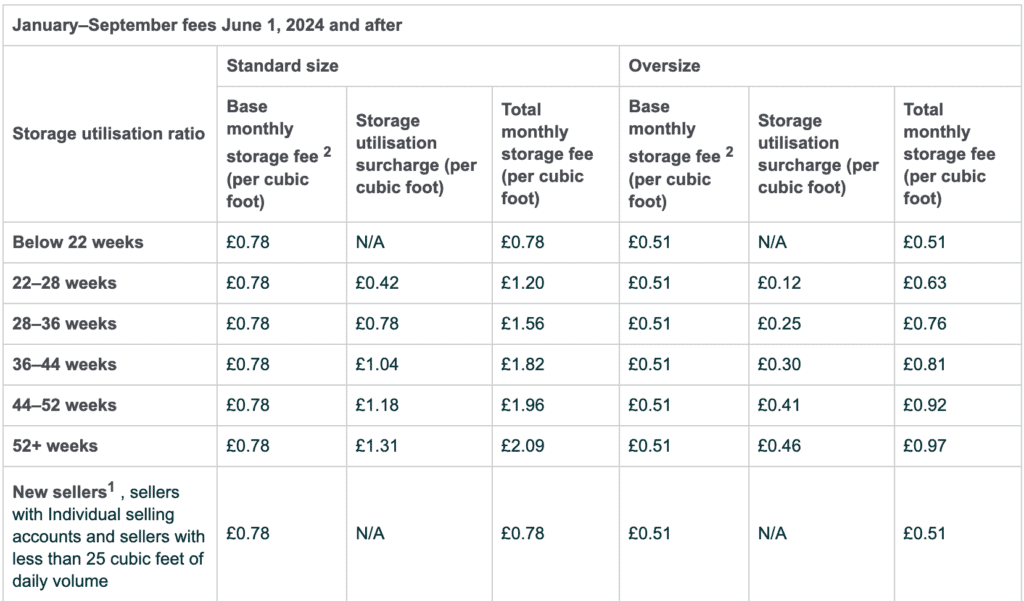
October-December Storage Utilization Surcharge
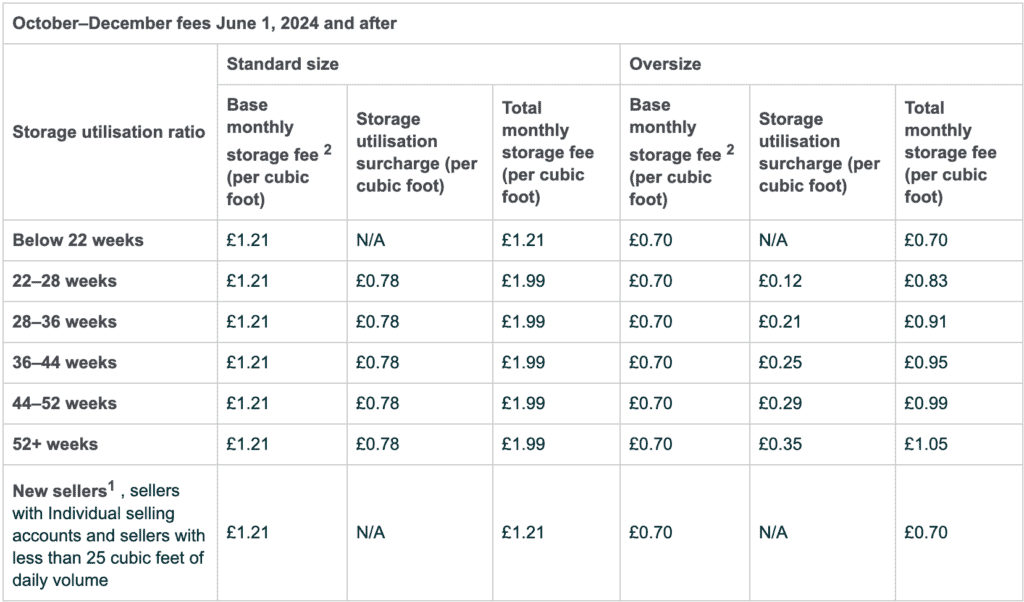
FBA Aged Inventory Surcharge
Another fee that’s tied to your storage is the aged inventory surcharge, which is set to increase by a little over 100% on February 15, 2024. This fee applies to inventory that has been stored over 270 days at FBA.
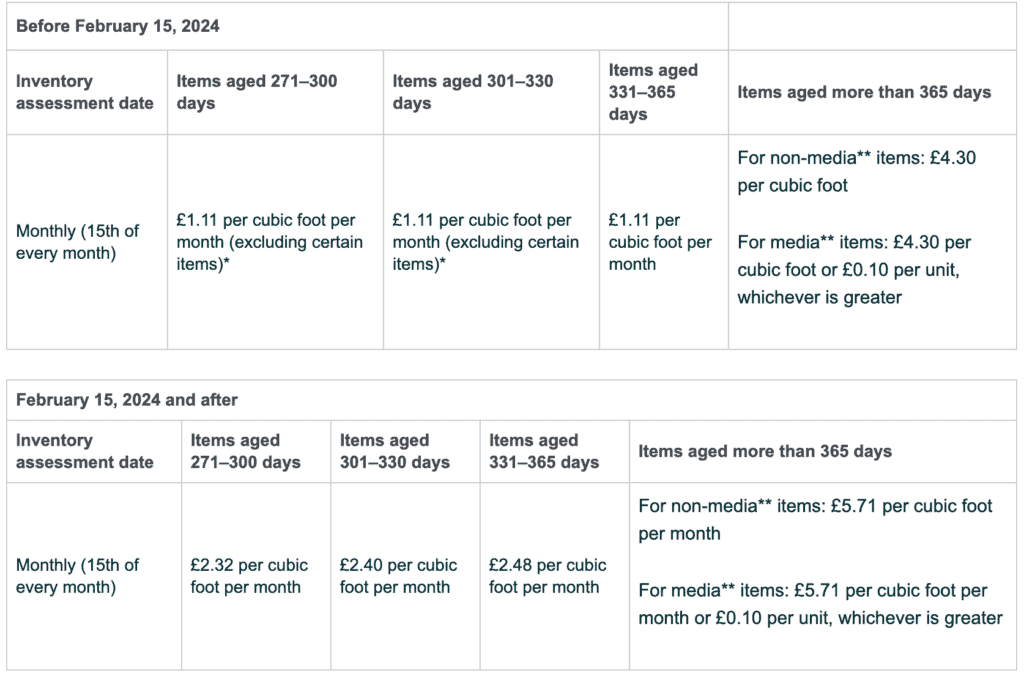
Pro tip: Check out our Attack of the Fee Stack white paper to learn how to minimize or avoid these storage-related fee increases.
FBA Return to Seller, Disposal and Liquidation Order Fees
Starting on February 5, 2024, seller return fees will get more expensive by around 40%.
Return to Seller Fees
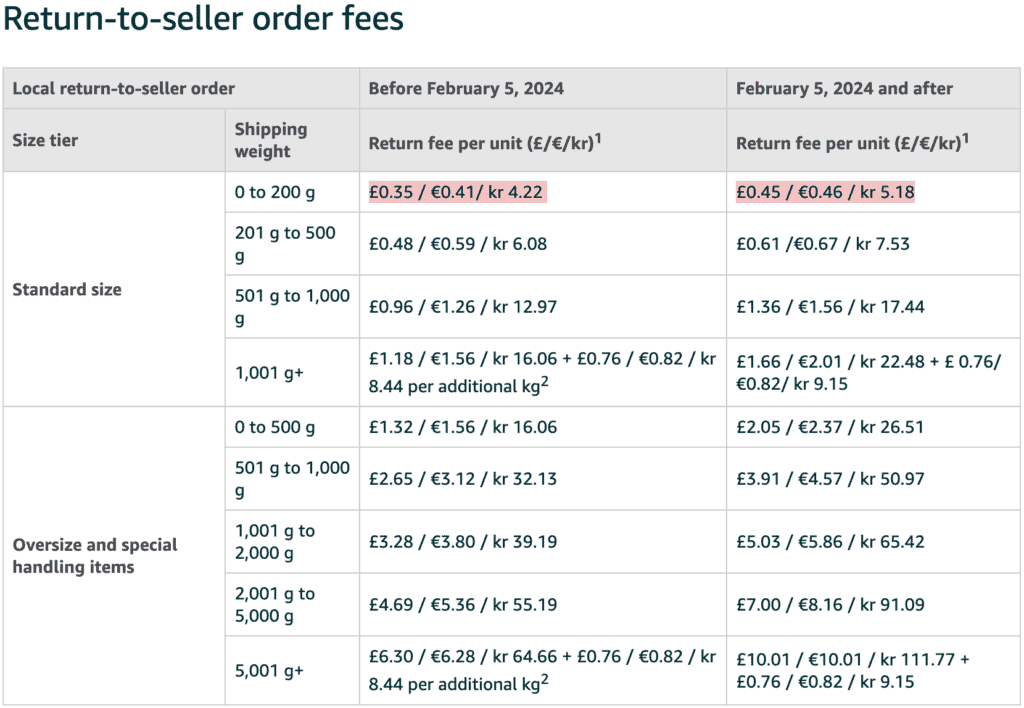
Disposal Order Fees

Liquidation Processing Fees
This fee is on top of Amazon’s 15% liquidations referral fee, which is calculated based on the item’s gross recovery value, while the liquidation processing fee is based on the item’s size and weight.
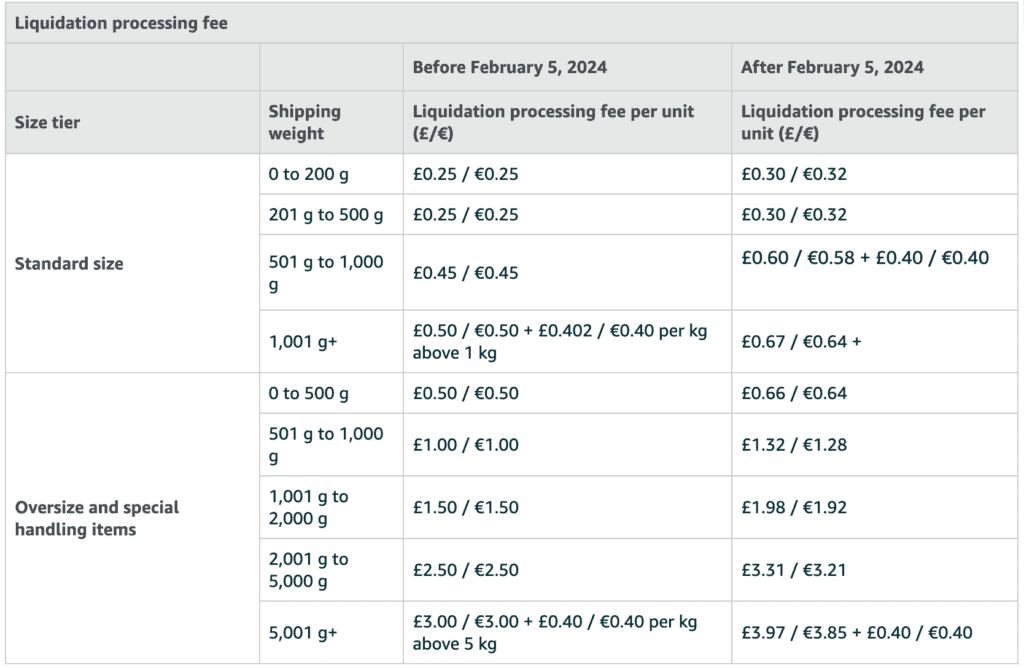
Related: 5 Best Options to Quickly Liquidate Amazon Inventory
Pan-EU FBA Oversize Eligibility Updates
Effective July 1, 2024, Amazon will revise the Pan-EU FBA surcharge eligibility for oversize products.
This surcharge is currently applied to the local fulfilment rates for the fulfilment of all oversize items via the Pan-EU program. Luckily, it could be waived in France, Italy and Spain if the eligible inbound destination is the same as the country of sale. Germany used to be exempt from this fee but will now see oversize surcharges if inbounding into a country different than the country of sale.
Failure to inbound Pan-EU inventory in the eligible sales country may prompt Amazon to distribute your units among EU fulfillment centers or fulfill remotely from enabled countries, incurring higher operational costs and slower delivery speed.
According to Amazon, eligibility will be based on “a new metric called the historical inbound-sales quantity.” It’s defined as the difference in the historical inbound receive quantity and the historical sales quantity for a given seller-FNSKU in a Pan-EU store. For a given store, the surcharge will apply to Pan-EU shipped units that are sold in the following week, only if the long-term (last 150 days) and short-term (last 30 days) historical inbound-sales quantity is less than zero.”
Sample calculation below:
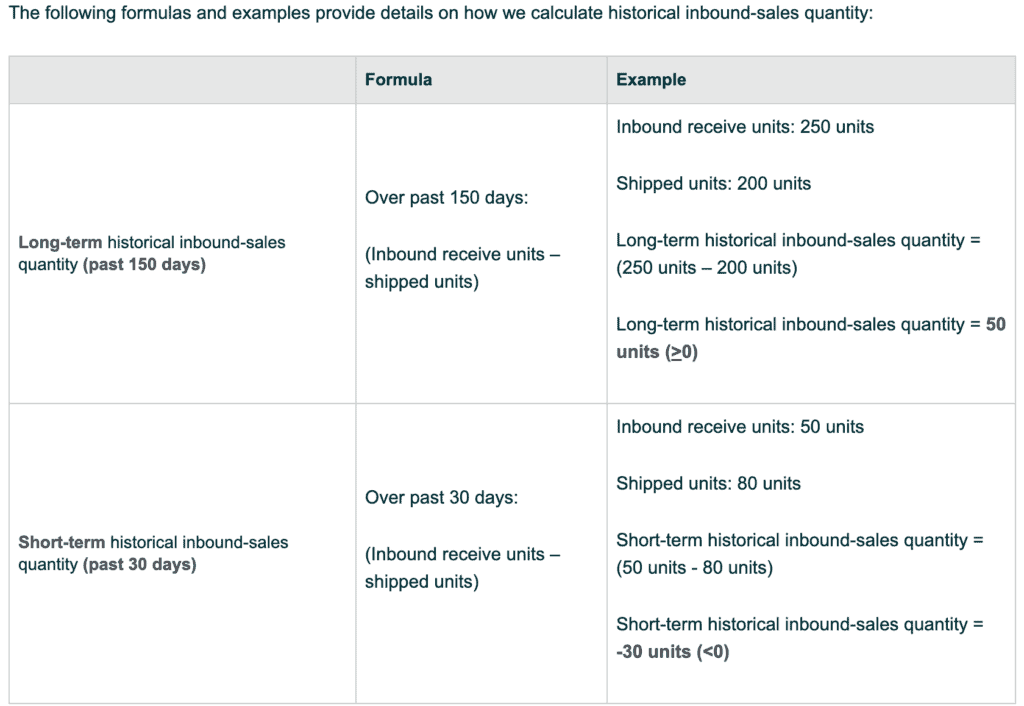
If both the long-term and short-term historical inbound-sales quantity of the product sent in France are below zero, you will likely incur the Pan-EU oversize surcharge.
| Pan-EU store: France | Size tier: Large oversizeShipping weight: ? 9.76 kg |
| Historical inbound-sales quantity | Historical inbound-sales quantity: < 0Long-term historical inbound-sales quantity: < 0Short-term historical inbound-sales quantity: < 0 |
| Total fulfilment fees | Standard FBA fulfilment fee: €20.60 per unit (standard rate for the size tier and shipping weight) Pan-EU surcharge for oversize items: €2.96 per unit (rate for < 0 historical inbound-sales quantity) Total new FBA fulfilment fees: €20.60 per unit + €2.96 per unit = €23.56 per unit |
To mitigate or eliminate the Pan-EU surcharge for a product with a historical inbound-sales quantity below zero, Amazon recommends adjusting your inbound destination. This may help to adjust the long or short-term quantity to a positive, so that the Pan-EU surcharge won’t apply.
Other Upcoming Changes
Returns Processing Fee. On October 1, 2024, a returns processing fee, ranging from £1.71 (small envelope) to £36.87 (special oversize) per unit, will be imposed for high-return-rate products across all categories, excluding clothing and shoes. (Clothing and shoes returns processing fees will apply for each unit returned as usual.) This fee aims to manage operational costs and minimize waste, and is applicable only to products exceeding a specified return rate threshold within each category.The return rate assess the monthly fees based on the number of shipped units per product within that month compared to the number of returned products within that month and the subsequent two months. For example, October fees will be assess by reviewing returns in October, November and December.
The initial charge is scheduled between December 7th and 15th, 2024. In October, you will be able to go to FBA Customer Returns dashboard to review your product’s return rate. Given the effective date of this fee change, sellers will have Q1-3 to optimize their product catalog to reduce returns liabilities. However, rate thresholds will not be revealed until August 1, 2024 and the dashboard won’t be available until October 1st. FBA New Selection Program Changes. Set to take effect on March 1, 2024, Amazon will continue to offer up to 10% rebate on sales of eligible brand-registered parent products that are new to FBA. The retailer will also provide sellers with eligible oversize products with rebate benefits on up to 50 units (previously 30 units) per parent product. A lower IPI score for eligibility will also soon apply, from 400 down to just 300. Lower FBA Fees for Ships in Product Packaging (formerly Ships in Own Container). Items approved for this program will enjoy reduced FBA fees automatically. Amazon may certify products if their packaging aligns with program guidelines, or items can be enrolled when packaging is adjusted to meet these criteria. Click here to view the updated rates.
Final Thoughts
In light of this announcement, sellers are urged to strategize and optimize for these shifts to maintain profitability amid changing policies.
While all of these fees add more complexity to an already labyrinthine web of FBA expenses, if you look a little deeper, you will see the need for continued focus on storage and shipping optimization as Amazon takes a more laser targetted approach to cost offsets. Rather than higher fulfillment costs across the board for all products and sellers, brands are beginning to be hit with fees based on more complex inventory behaviors.
Navigating through new fees and price hikes demands heightened attention to inventory management. From Low-Inventory-Level fees to expanded Storage Utilization Surcharges, balancing understocking and overstocking in FBA becomes even more crucial to avoid incurring added costs. Precise insights into sell-through rates and demand are essential for optimizing costs amidst these FBA adjustments.












